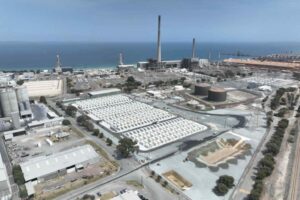Leading economist Ross Garnaut has flagged the decline of centralized generation, saying Australia’s best prospects for a cheap energy future lie in a decentralised, and decarbonised grid.
This, he said, would require the current government to implement important reforms, accept environmental considerations, and embrace, rather than fight, technology advances such as rooftop solar.
 In a wide-ranging speech in Melbourne, delivering the John Freebairn lecture, in which he also flagged the likelihood of “trench warfare” over the conflict between the environment and the resources industry, Garnaut said centralised generation was clearly in decline, with its foundations “cracked and shaken” by new technologies such as solar PV.
In a wide-ranging speech in Melbourne, delivering the John Freebairn lecture, in which he also flagged the likelihood of “trench warfare” over the conflict between the environment and the resources industry, Garnaut said centralised generation was clearly in decline, with its foundations “cracked and shaken” by new technologies such as solar PV.
“With solar photovoltaic costs continuing to fall and Australians like other consumers finding ways to use less electricity, demand for power from the centralized system is likely to continue to shrink,” Garnaut said.
“The centralized system was once a major growth industry. It is time to think of it as an important but shrinking provider of services that are complementary to an expanding decentralized system.
“Getting this relationship right will maximize the likelihood of gradual restoration of Australia’s position as an economy with low-cost energy, facilitate the transition towards expanded use of renewable energy, and preserve a larger and economically more valuable role for the centralized system.”
Garnaut says Australia’s historical advantage in cheap energy had been squandered by over-investment in the networks, the dominance of a few major retailers, and the surging price in fossil fuels.
Eastern Australia, which once had the lowest gas prices in the developed world, is on a path soon to be the highest outside East Asia. Contrary to others who say local prices will be below export prices (net of costs of LNG conversion and shipping), Garnaut predicted domestic prices may rise to “well above” export parity prices because the export capacity exceeds current supply.
Garnaut believes that the wholesale electricity market should be left as is. Incumbent generators, who have long benefited from windfall profits from rising demand and peaks, are now calling for changes to the market rules, wanting payments for generators when not in use (capacity payments), and exit payments to help with the cost of “remediation”.
Garnaut says these claims are a nonsense. The current fall in wholesale prices caused by the influx of renewables will balance itself when some fossil fuel generators are forced to leave the market. Renewables will still keep the cost of wholesale electricity below where it was otherwise.
“The wholesale market is a success story, and should be left to continue as it is,” he says. “If low prices lead to the withdrawal of one or more generators in the period ahead, the market is working as the market should. If they do not, as each supplier hopes that others will close first, the consumer will benefit from a longer period of low prices.”
However, Garnaut argues for changes to other parts of the electricity market, where transmission and distribution networks operate as natural monopolies.
This has caused difficulties on pricing regulation, resulting in an investment in networks well beyond other developed countries. This excess and unnecessary investment is the primary cause of rising consumer costs, making rooftop solar more attractive, leading to further reductions in demand and higher prices as network operators seek to secure their “guaranteed rate of return.”
He suggested having greater competition that would allow retailers and distributors to compete in the same market – something that some network operators have canvassed as they look to future distributed generation models and micro grids. Garnaut says integrating distribution and retail functions would expand opportunities for cooperation between energy service suppliers and users to reduce electricity costs.
He warned that charging for capacity would encourage an increasing proportion of users to leave the grid entirely—more as costs of storage fall. “Established suppliers in the centralized system will need to meet this competitive challenge by minimising costs and increasing the advantages of using the grid as a complement to decentralized supply of power,” he said
He raised the prospect that existing networks may have to be written down, as a circuit breaker on electricity costs, if the centralised model would retain its role.
He also cautioned about the prospect of network asset sales by the state government, saying uncertainty about pricing reform would undercut asset prices, but committing to established pricing systems would effectively block efficient reform.
“Early movement to a world in which low-emissions energy plays a large role in all countries would facilitate the re-emergence of relatively low energy costs in Australia. The superior renewable energy resources of Australia would allow low cost production, and their increased use would be more completely reflected in low domestic prices than are Australia’s superior resources of internationally tradable fossil energy.
“Efficient integration of decentralized provision of power with the established network would also facilitate the re-emergence of relatively low energy costs in Australia, allowing users to introduce proportions of low-cost decentralized power into their private energy mix. “
He recommended the status quo on key energy policy, rather than the proposed dismantling of the carbon price, the renewable energy target, and key institutions such as the Clean Energy Finance Corporation, the Australian Renewable Energy Agency, and the Climate Change Authority.
Restoring policy certainty would allow the current 41,000GWh target to be met, contrary to the claims of some retailers, and ARENA would help reduce the future cost by accelerating the introduction of new low emissions technologies into Australia— where, he said, the activities of pioneering firms have large spillover benefits for others.
“The combination of increasing renewable power supply and declining wholesale demand would continue to put downward pressure on wholesale power prices. Sooner or later there would be withdrawal of established coal and gas generation capacity. “
He also said other countries are reducing their energy intensity, China and other nations were moving to more decentralised generation, and this had large implications for Australia, even if the current government, policy makers and vested interests tried to ignore them.
“The actions of others have changed radically the demand for coal, and left many billions of dollars of investment in coal mining without any prospect of shareholders receiving even the cost of their capital,” he said. “The actions of others have brought down the costs of renewable energy to the extent that the economic foundations of the old centralized power systems have been shaken and cracked.”
“Australia has immense advantages as a producer of energy. We now must use these advantages in the low carbon world to which the rest of the world has been travelling gradually and along which it will continue to travel slowly or fast. This is the world for which Australians must construct energy policy for the future. “
Garnaut said that the move to repeal the carbon price and replace them with an “ineffective” Emissions Reduction Fund “does not make sense to anyone who understands the implications of modern science on climate change. “
Ironically, the future of both policies was likely to be tied up in the Senate over budget considerations. And retaining the carbon price could address many of the budget issues, and make up the balance of some of the unpopular measures now likely to be rejected in the Upper House.
“Retention of carbon pricing and rejection of the Government’s Emissions Reduction Fund would reduce the budget deficit by $6-7 billion in 2014-5, and a total of $6-12 billion in the following three years depending on the European Emissions Trading System’s carbon price,” Garnaut notes.
“By coincidence, retention of carbon pricing would more or less precisely fill the gap from Senate rejection of some Budget measures.
“To put it another way, Australia can stay within the boundaries of fiscal responsibility over the next four years as defined by the Government in this year’s Budget by retaining carbon pricing rather than the array of changes that are at risk in the Senate.”








